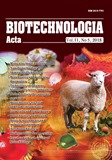ISSN 2410-7751 (Print)
ISSN 2410-776X (Online)

"Biotechnologia Acta" V. 11, No 5, 2018
https://doi.org/10.15407/biotech11.05.065
Р. 65-74, Bibliography 25, English
Universal Decimal Classification: 602.1:519.673+602.3:579.864
Lactobacillus AS PRODUCERS OF EXTRACELLULAR TANNASE
L. Oriabinska1, O. Dziuba1, 2, O. Dugan1
1The National Technical University of Ukraine “Igor Sikorsky Kyiv Polytechnic Institute”, Kyiv
2Palladin Institute of Biochemistry of the National Academy of Sciences of Ukraine, Kyiv, Ukraine
The aim of the work was to find strains of lactic acid bacteria capable to synthesize extracellular tannase enzyme ? the key enzymehe hydrolyzing tannins which are plant food constituent. One of the main product of tannins hydrolyzis is gallic acid- the compound with proven antioxidant and onco-protective properties. As a result of lactobacteria screening, two biocompatible strains of lactic acid, namely L. rhamnosus LB3 and L. delbrueckii subsp. delbrueckii with a high level of enzyme productivity, were selected. The maximum accumulation of tannase, corresponding to 0.031 ± 0.002 U/ml for L. rhamnosus LB3 and 0.03 ± 0.002 U/ml for L. delbrueckii subsp. delbrueckii, was observed after 48 h of cultivation. Both strains showed rapid growth and performance of tannase in MRS medium in the presence of glucose or lactose as a carbon source. It was shown that gallic acid, which was a necessary component of the medium as a target enzyme inducer, did not affect the accumulation of lactobacilli biomass. The selected strains are of interest as producers of a bicomponent probiotic with antioxidant properties and require further investigation.
Key words: lactobacillus, probiotics, tannase, antioxidants, carbon sources.
© Palladin Institute of Biochemistry of National Academy of Sciences of Ukraine, 2018
References
1. Parmjit S. Panesar Fermented Dairy Products: Starter Cultures and Potential Nutritional Benefits. Food Nutr. Sci. 2011, 2, Р. 47–51. https://doi.org/10.4236/fns.2011.21006
2. Pritib Shinde Probiotic: an overview for selction and evaluation/PRITI B. SHINDE. Int. J. Pharm. Sci. 2012, 4(2), Р. 14–21.
3. Kan Shida Probiotics as efficient immunopotentiators: Translational role in cancer prevention. Ind. J. Med. Res. 2013, N 138, Р. 808–814.
4. Starovoytova S. A Oriabinska L. B., Gorchakov V. Y. , Dugan О. М. Anti-mutagenic activity of lactic acid bacteria. Scientific Bulletin of the National Mining University. 2008, No 5, Р. 53–56. (In Ukrainian).
5. Shinkarenko L. B., Oriabinska S. A., Starovoytova Antimutagenic action of the blastan preparation. Scientific Bulletin of the National Mining University. 2008, V. 4, Р. 77–81. (In Ukrainian).
6. Varsha A. Singh, Ruhi Bunger. Singh Probiotics and Gut Health. JIMSA 2014, 27 (1), 41–45.
7. Mongkol Thirabunyanon Biotherapy for and protection against gastrointestinal pathogenic infections via action of probiotic bacteria Maejo. Int. J. Sci. Technol. 2011, 5 (1), 108–128.
8. Vanessa Li?vin-Le Moal, Alain L. Servina. Anti-Infective Activities of Lactobacillus Strains in the Human Intestinal Microbiota: from Probiotics to Gastrointestinal AntiInfectious Biotherapeutic Agents. Clin. Microbiol. Rev. 2014, 27 (2), 167–199.
9. Urszula Daniluk. Probiotics, the New Approach for Cancer Prevention and/or Potentialization of Anti-Cancer Treatment. J. Clin. Exp. Oncol. 2012, No 1, Р. 1–2 . https://doi.org/10.4172/2324-9110.1000e105
10. Aguilar C. N. Review: Sources, Properties, Applications and Potential uses of Tannin Acyl Hydrolase. Food Sci. Technol. Intern. 2001, V. 7, P. 373–382. https://doi.org/10.1106/69M3-B30K-CF7Q-RJ5G
11. Lenka P. К., Lonsane B. K. Production and application of tannin acyl hydrolase: State of the art. Adv. Appl. Microbiol. 1997, 44, 215–260.
12. Bhat T. K., Singh B., Sharma O.P. Microbial degradation of tannins – a current perspective. Biodegradation 1998, 9 (5), 343–357.
13. Smith A. H., Zoetendal E., Mackie R. I. Bacterial mechanisms to overcome inhibitory effects of dietary tannins. Microb. Ecol. 2005, 50 (2),197–205.
14. Mingshu L., Kai Y., H. Dongying Q. J. Biodegradation of gallotannins and ellagitannins. J. Basic Microbiol. 2006, 46 (1), 68–84. https://doi.org/10.1002/jobm.200510600
15. Belmaresa R., Contreras-Esquivela J. C., R. Rodr??guez-Herreraa, A. R. Coronelb, C. N. Aguilara Microbial production of tannase: an enzyme with potential use in food industry. Food Sci. Technol. 2004, 37 (8), 857–864. https://doi.org/10.1002/jobm.200510600
16. Purohit J. S., Dutta J. R., Nanda R. K., Banerjee R. Strain improvement for tannase production from co-cultureof Aspergillus foetidus and Rhizopus oryzae. Bioresour. Technol. 2006, 97, 795–801. https://doi.org/10.1016/j.biortech.2005.04.031
17. Yumnam S., Prasanna В., Oriabinska L. B., Khrokalo L. A., Dugan O. M. Оptimization of tannase positive probiotic production by surface response. Biotechnol. аcta. 2014, 7 (5), 62–70. https://doi.org/10.15407/biotech7.05.062
18. Glushanova N. A., Shenderov B. A. Interaction of probiotic and indigenous lactobacilli of host in conditions of joint cultivation in vitro. J. microbial., epidemiol. and an immunobiol. 2005, No. 2, P. 56–61. (In Russian).
19. Postnikova E. A., Yefimov N. N., Volodin L. I., Kafarskaya L. I. Search for promising strains of bifidobacteria and lactobacilli for the development of new biopreparations. ZHMEI 2004, V. 2, Р. 64–69. (In Russian).
20. Beili N. Statistical Methods in Biology. Moscow: Publishing House of Foreign Literature. 1962, 260 p. (In Russian).
21. Jana A., C Maity, Halder S. K., Mondal K. C., Pati B.R., Mohapatra P. K. Enhanced tannase production by Bacillus subtilis PAB2 with concomitant antioxidant production. Biocatal. Agric. Biotechnol. 2013, V. 2, P. 363–371. https://doi.org/10.1016/j.bcab.2013.06.007
22. Sivashanmugam K., Jayaraman G. Production and partial purification of extracellular tannase by Klebsiella pneumoniae MTCC 7162 isolated from tannery effluent. Afr. J. Biotechnol. 2011, V. 10, P. 1364–1374.
23. Wilson P. A., Rojan P. J., Kuma P., Sabu T. Tannin acyl hydrolase production by Citrobacter sp. isolated from tannin rich environment, using Tamarindus indica seed powder. J. Appl. Sci. Environ. Manage. 2009, V. 13, P. 95–97. https://doi.org/10.4314/jasem.v13i4.55434
24. Bradoo S., Gupta R., Saxena R.K. Parametric optimization and biochemical regulation of extracellular tannase from Aspergillus japonicas. Proc. Biochem. 1997, V. 32, P. 135–139.
25. Rodriguez H., Rivas B., Gomez-Cordoves C., Munoz R. Characterization of tannase activity in cell-free extracts of Lactobacillus plantarum CECT 748T Int. J. Food Microbiol. 2008, V. 121, P. 92–98. https://doi.org/10.1016/j.ijfoodmicro.2007.11.002

